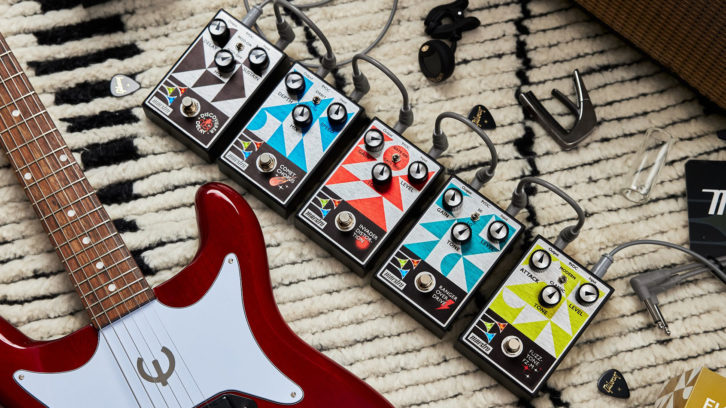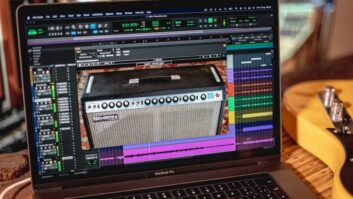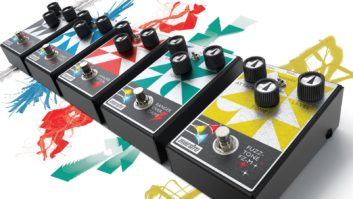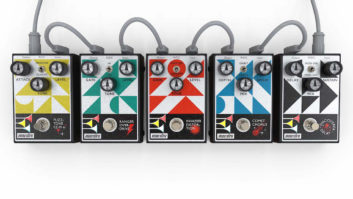
As the founder of effects, Maestro commercialized the world’s first guitar pedal, the Fuzz-Tone, in 1962. The brand blossomed through the early 1970s thanks to legendary musicians like George Harrison, Pete Townshend and Eric Clapton, who called on Maestro to shape their signature sound. The most iconic perhaps is Keith Richards’ groundbreaking riff in the Rolling Stones’ “(I Can’t Get No) Satisfaction.”
While the brand stopped creating new effects pedals around 1978, it continues to be a favorite among guitarists. So, Gibson has reinvigorated the brand with the Maestro Original Collection— five new pedals designed, voiced and styled for musicians. In tribute to the brand’s 1960s-era origins, each pedal features a design and color scheme of its classic rock days, with modernized features, expanded versatility and advanced tone-tweaking capabilities. They’re fundamental pedals and priced affordably, so every player can get them.
This refresh was the perfect opportunity to properly honor the past while pushing into the future. The biggest update is the adoption of modern electronic parts to capture Maestro’s originality and timeless tone in a way that’s highly reliable and reproducible. They’re all undeniably classic analog and true bypass, with modern parts to ensure continued product availability.
We found that the cool factor from Maestro’s heyday is sought after today, so we worked hard to keep the aesthetic vibe and undeniable tone. The aesthetics were very much derived from the early style of Maestro, using geometric shapes, and adding cool new elements, like the lighted bugles in the logo. We also borrowed the wedge shape of the original pedals but scaled down the size to be more compatible with modern pedalboards, and we put the jacks on the front because that’s more conducive for compact pedalboard layouts.
Maestro Original Collection – A Real-World Review
We took a meat and potatoes approach to develop the range. Each has three knobs and a single toggle switch, with as much versatility as possible within that format. The team did a great job making the controls flexible and wide-ranging.
We designed the Fuzz-Tone to be innovative and reminiscent of the pedal’s heritage. It’s silicon-based, unlike the original Geranium-based fuzz, with a similar voice and characteristic in the classic setting. We also added a modern setting with more body and a different tone stack for added versatility. It’s a great pedal for tone and stacking dirt pedals, and creates nice sonic areas that fit well within a mix.
The Ranger Overdrive is a versatile and unique tone sculpting pedal with a wide range and two settings that go from heavily saturated to very articulated. This pedal also runs at 12 volts for added headroom and dynamics.
Maestro isn’t known for distortion pedals, but the feedback on the Invader Distortion has been great. It has a built-in noise gate and trim pot to adjust the threshold, creating a huge range. You can get heavy, distorted, saturated metal tones, as well as a clean, beautiful rock-and-roll sound. It’s raw, in-your-face distortion that makes you want to play.
For modulation, we have the Comet Chorus and Discoverer Delay, which are both great. In the mix world, there’s so many plug-ins to create a vintage analog sound. If you’re looking for authenticity, these are the real deal.
We went at the Chorus in a different way, giving it its own vibe that’s voiced warm and fits well in a mix. It’s a bucket brigade chorus and has a wide range of tones and a swirly character that you can dial to taste. In orbit mode, it creates rotary speaker like amplitude modulation, synced with the timing of the chorus, while a trim pot adjusts the level of the rotary speaker effect. The blend of effects adds tons of flexibility; you can get so many different sounds.
The Delay is a classic analog bucket brigade delay unlike anything on the market. It’s beautiful-sounding in a very classic, tape-like, analog way. The tonal quality of the repeats has a ton of character, and the modulation is unique and adjustable. It’s an inspiring pedal; you just want to keep playing and applying new possibilities.
Looking to the future, Maestro will continue to expand. There’s a five-year-long roadmap that includes reissuing some vintage stuff. We want to get back to Maestro’s innovative roots (in a modern way), but also take it anywhere customers want to go. We’ll do that by creating familiar effects and tones in different ways, as well as ones that have never been done before. The future is definitely long and bright for this brand.







